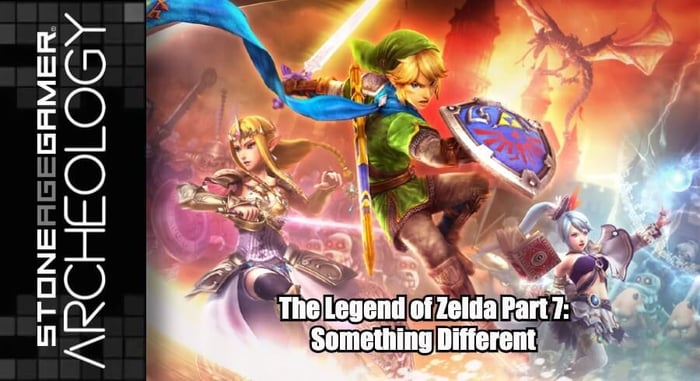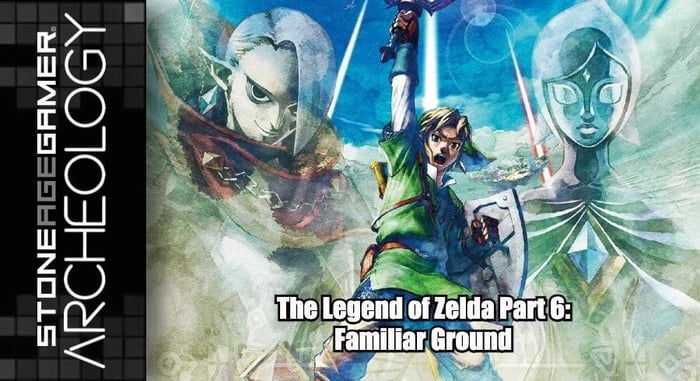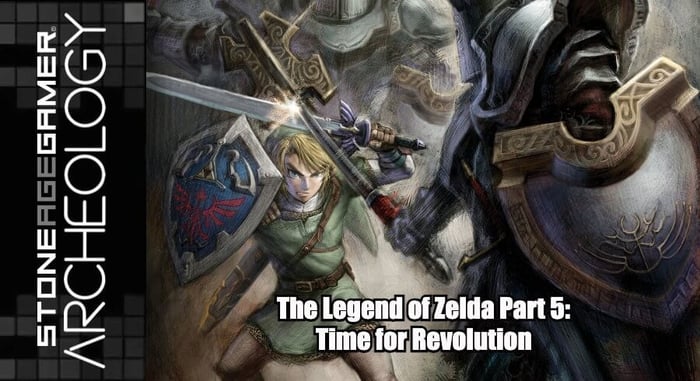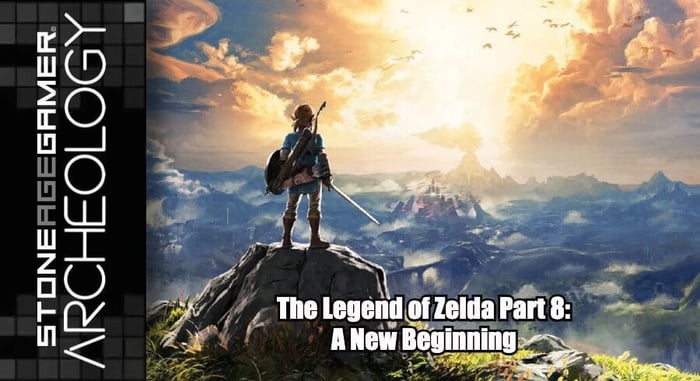
The Legend of Zelda Retrospective Part 7 - Something Different
Welcome to Part 7 of our 8-part Zelda retrospective. In this episode, we look at a series of unusual releases, including a Zelda "Dynasty Warriors" spinoff, and a three-player game focused on fashion, as well as a number of stopgap releases intended to hold fans over until Zelda for Wii U.
In this series, we aim to tell the story of the Zelda series as it unfolded for North American audiences. We are not only looking at the games themselves, but the historical context surrounding them, and what it was like being a fan as these games were being released.
Watch more Stone Age Gamer Archeology: https://youtube.com/playlist?list=PLoWJAVdwC7Z_CC...
Transcript of the video:
Even with the next evolution of the Legend of Zelda series well underway, there was an undeniable prevailing sense of uncertainty surrounding the series. Nintendo’s decision to rethink the conventions of The Legend of Zelda had the potential to go very well, but things could just as easily go very poorly. So when the December 2013 Nintendo Direct presentation was announced, fans couldn’t help but wonder if this was where they’d finally learn something about the new Legend of Zelda. It turns out the answer was… sort of.
At the top of the presentation, Nintendo CEO Satoru Iwata announced that the first game shown would be a collaboration between Nintendo and Tecmo/Koei, and it would combine the gameplay of their long-running Warriors franchise with the world of The Legend of Zelda. The game was Hyrule Warriors, and the reaction was mixed.
Mr. Iwata immediately clarified that this new game was not the next main installment in The Legend of Zelda series, but merely a fun spinoff. The footage looked interesting, but not enough to distract from what fans were really after.
Nintendo then hosted another Direct presentation in February 2014 without a single mention of either Hyrule Warriors or Zelda for Wii U. Tensions were getting high, and speculation was running rampant, but relief finally came four months later.
It was with baited breath that the gaming press and fans alike tuned in to Nintedo’s E3 2014 presentation for the first proper unveiling of Zelda’s new direction.
The show started off in an uncharacteristically self aware form, with direct references to Nintendo’s continued refusal to localize Mother 3, Adult Link not wanting Toon Link around, and company CEO Satoru Iwata and Nintendo of America president Reggie Fils Aime engaging in a martial arts battle to promote Super Smash Bros. for Wii U. It was a remarkably fun presentation, but about halfway through Zelda series producer Eiji Aonuma took center stage to finally discuss Zelda for Wii U.
He began by talking about how the new game’s development was being based on the sense of exploration players experienced in the original Legend of Zelda. They had been attempting to recreate this open world exploration feel in games like The Wind Waker for years, but they were never able to accomplish exactly what they were going for. Now, their vision had been realized, and they were ready to share it with the world.
As the first footage of the game appeared behind him, he explained that this new world of Zelda was going to be more vast than anything before, with the ability to reach any area from any direction however you want, effectively jettisoning the more rigid structure the Zelda series had exhibited for years. Then, as the image of Aonuma left the screen, fans were treated to their first taste of what to expect from The Legend of Zelda on Wii U.
The presentation immediately moved onto the next game, giving fans no time to process the confusion and excitement over what they had just witnessed. Some were bewildered by the appearance of advanced technology, while others weren’t sure the protagonist was even still Link. Questions were limitless, but one thing was certain, excitement for the game had never been higher. The new footage successfully impressed, but the game was still a long way off. In the meantime, Zelda fans were about to get a crash course in a very different kind of game.
Hyrule Warriors released for the Wii U in September 2014, combining Tecmo/Koei’s long running Warriors franchise with elements of The Legend of Zelda. The game put players in a massive battlefield, and it was up to them to utilize over-the-top moves to take down hordes of enemies, while managing the various facets of the battle taking place in multiple locations.
Following one of Gannondorf’s previous defeats, his soul was split into four fragments and scattered through time and space. One was sealed in the Master Sword, while the other three went to the worlds of Ocarina of Time, Twilight Princess, and Skyward Sword. Using a sorceress named Cia, Gannondorf was able to open the Gate of Souls and summon an army to attack Hyrule Castle. During the battle, a soldier named Link discovered that he was in possession of the Triforce of Courage. Princess Zelda though, had disappeared, and so Link teamed up with the Hylian general Impa to track her down.
During the course of the adventure, Hyrule Warriors presented players with a unique opportunity to play as a number of different characters from throughout the entire Zelda franchise, many of which were added via updates and DLC. Multiple incarnations of Link from games past came with their own unique movesets and art styles, but the playable roster expanded far beyond him to include the likes of Midna, Skull Kid, Zelda, and Gannondorf himself. Even unexpected characters like Tingle, The King of Red Lions, and Ravio made the cut, alongside new characters created just for Hyrule Warriors like Volga and Linkle.
The finer points of the game’s story get rather convoluted in service of trying to explain how all these characters could coexist in the same universe, but the plot itself was secondary to the fan service on display. Everything from the game’s map to its sound effects were an homage to the series legacy, and while the gameplay didn’t catch on with every Zelda fan, most were happy to at least give it a try, which ultimately proved to be a great success, eventually earning the game multiple re-releases and enhancements on future platforms.
Three months later, The 2014 edition of The Game Awards were held. During the event, Nintendo hosted a surprise presentation where they showed off the first actual gameplay footage of The Legend of Zelda for Wii U. Series creator Shigeru Miyamoto joined Eiji Aunoma to show early off-screen footage of the game in action, and how their experiments had been paying off. The world was massive, requiring the use of the sailcloth from Skyward Sword as well as horses to traverse. The audience was wowed by the game’s progress, but even though they made a point of promising it would release in 2015, the wait was going to be much longer than that. Fans would have to get their next Zelda fix somewhere else. That somewhere turned out to once again be the 3DS.
The Legend of Zelda: Majora’s Mask 3D released in February 2015 for the Nintendo 3DS, giving the N64 cult classic the same treatment as Ocarina of Time four years prior. Termina never looked better with enhanced textures, improved geometry, and all new character models bringing the world to life like never before. A number of refinements were added in an effort to make the game’s 3-day cycle and obtuse nature more manageable, but unfortunately not every change was for the better. The game’s physics were altered, but the environments were not, leaving certain areas considerably more cumbersome to traverse than in the original, while aspects of its difficulty were lowered to the point of no longer being fun.
But in terms of making the game more accessible, it succeeded as many new fans were much more willing to give this iteration a fair shake. Unfortunately, that didn’t translate to better sales, with Majora’s Mask 3D failing to move even as many copies as its Nintendo 64 counterpart.
The reinvention that Zelda for Wii U promised was in dire need, but behind the scenes, significant changes were being made, which would lead to the game being delayed even further. However, Nintendo was also working on something else for Zelda fans, and as had been the case so many times before, it wasn’t at all what was expected.
The Legend of Zelda: Tri-Force Heroes was released in October 2015 for the Nintendo 3DS, and was once again a multiplayer focused adventure. Unlike Four Swords though, Tri-Force Heroes was a three-player affair, and featured an unusual focus on fashion.
Some time after the events of A Link Between Worlds, Link traveled to the kingdom of Hytopia. There, Princess Styla had been cursed by a witch to only be able to wear an ugly brown outfit, a fate that caused her to lock herself in her room, sending the kingdom into turmoil. King Tuft sent word that he was looking for three adventurers to become something called Totem Heroes, travel the Drablands, track down the witch to lift the curse, and save the kingdom.
Naturally, Link answered the call, and headed to a castle chamber to talk to an old man who would either help Link begin his adventure by creating two copies of himself to be controlled by other players, or granting him the use of Doppels, dolls that could be manipulated for single player play.
Regardless of how many players were involved, one of the game’s primary mechanics centered around the three Links having to stand on top of one another to form totems. This forced players to work together to solve puzzles and fight bosses in a unique way, and much like in Four Swords resulted in an experience that was equal parts cooperative and competitive. As expected, after a number of dungeons, battles, and costume changes, the Links were able to defeat the witch and return Styla to her old self, saving the kingdom in the process.
Tri-Force Heroes had an unusual tone for a Zelda game, standing as the least self-serious entry in the franchise to date. But while the actual gameplay could be very fun with three players, many felt the experience was lacking. Reception was mixed with some outlets awarding it high honors thanks to its clever puzzle design, unique style mechanics, and music in a similar vein to A Link Between Worlds, but others found the single player game to be somewhat tedious, characters uninteresting, and the overall stakes too low. At the time of its release, it was among the lowest selling Zelda games ever, only outperforming Four Swords Adventures for GameCube and the CD-i games.
By 2016, it had been three years since Nintendo released The Wind Waker HD as a holdover for fans who had already been waiting on Zelda for Wii U since 2011, but even after showing gameplay at The Game Awards over two years prior, the game still wasn’t ready. Nintendo needed more time, so they once again looked to the past.
The Legend of Zelda: Twilight Princess HD released for Wii U in March 2016, bringing Link’s most popular adventure to date into high definition for the very first time. Like the Wind Waker HD before it, the game featured upgraded textures, touchscreen inventory management, and several other minor tweaks. However, the result this time around wasn’t quite the same. Where Nintendo was careful and thorough in making The Wind Waker work as well as possible in HD without betraying the original’s charm, Twilight Princess HD was a much more straightforward port. Textures were enhanced, but the game’s inherent art style didn’t upscale quite as easily as Wind Waker’s more simplistic design, and since the porting process was outsourced to third party company Tantalus, some of the finer details like the game’s lighting didn’t work quite as well as they could have. Still, the enhancements that existed were greatly appreciated, especially the streamlining of the Tears of Light quests, which were a point of contention among fans of the original release.
But the Wii U wasn’t the only way fans got to revisit the world of Twilight Princess, as 3DS owners were treated to yet another completely different kind of Zelda game.
My Nintendo Picross - The Legend of Zelda: Twilight Princess was released on the 3DS in March 2016 exclusively as a reward for My Nintendo rewards club members. While not exactly a Zelda game in the strictest sense, it was a completely unique version of Nintendo and Jupiter’s long-running Picross series themed entirely around The Legend of Zelda: Twilight Princess. Picross is a puzzle game where players must use numbers on a grid in order to draw a picture. Each number corresponds with a number of tiles that need to be colored in, once all of the necessary blocks are filled, an image of a character or item from Twilight Princess would be revealed. The further you get in the game, the more complex the puzzles become, with 45 puzzles in all ranging from 10 x 10 grids all the way up to 20 x 15.
The action was hosted by Midna who gave players basic information as they played, all set to a unique musical score based on the themes from Twilight Princess.
My Nintendo Picross - The Legend of Zelda: Twilight Princess was a small experience, but a welcome one considering it was effectively free for My Nintendo members, and offered fun and engaging puzzle gameplay. Ultimately though, much like the past several releases in the Zelda series, it was nice, but it was still a distraction from the bigger picture. Unfortunately, the wait for more information would still be longer as following this release there would be no news on the Zelda series for over a year. But what waited for fans on the other side was exactly what Nintendo had promised, and if all went well, this new game would be the breath of fresh air the series needed.
Join us next time when Zelda once again shifts to new hardware, and Nintendo finally delivers on their bold new direction years in the making.





